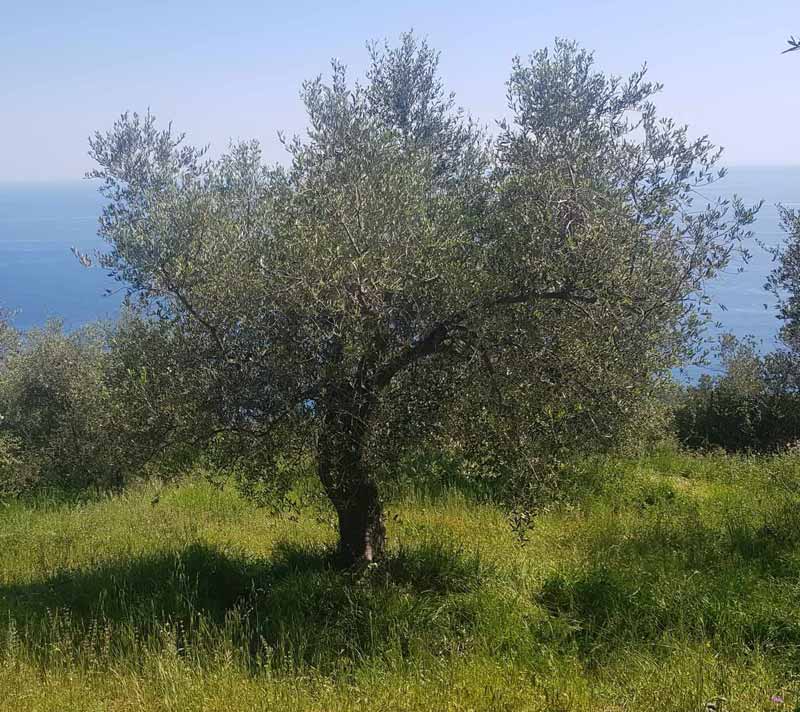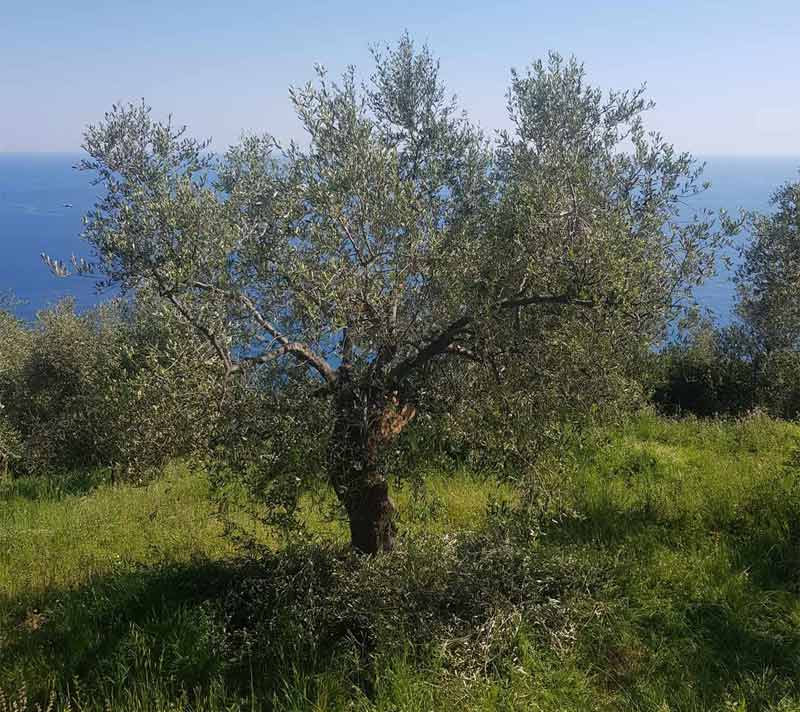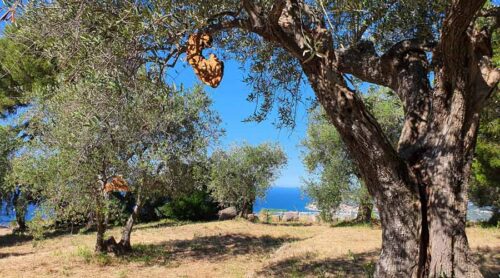Drag the white line to the right or left to see the before/after effect.


Pruning olive tree: experience, knowledge and a lot of love for the trees
The picturesque farm Sassolive grows over 1,200 organically grown olive trees. These trees need careful and competent care to reach their full potential and deliver the expected harvest. In particularly productive years, this careful management can result in the production of up to 2,000 liters of premium organic olive oil.
The maintenance cycle of these olive trees follows a fixed annual schedule:
- Pruning olive tree in January and February: this step is essential to ensure the optimal structure of the tree and prepare it for the coming year of growth.
- Fertilizing in March and April: Targeted fertilization ensures that the tree receives all the necessary nutrients to grow vigorously and bear abundant fruit.
- Protection in summer: in the hot months it is important to protect the tree from extreme conditions and pests.
- Harvest from October 1: This is the culmination of a year of hard work, carefully harvesting the ripe olives.
A crucial factor for the success of the season is the rain, especially in December and January. Olive trees form their inflorescences during this time. A lack of water at this crucial stage can result in fewer flowers forming and significantly affect crop yields for the year.
While olive trees generally require less water than many other tree species, they are not immune to extreme drought. As was observed in 2022, prolonged drought can cause the trees to shed their olives as they do not have enough resources to fully develop the fruit.
Pruning olive trees for agricultural purposes is quite different from ornamental pruning. It requires a deeper understanding and greater experience. The primary goal is to maximize fruit production and ensure consistent olive quality. Ideally, an olive tree for agricultural purposes should not exceed 3 to 4 meters in height. This greatly facilitates the harvest.
In situations where olive trees grow too high (up to 6 meters), radical pruning can be carried out when pruning olive trees. This drastic step leaves almost only the main stem with a few shoots. After such a radical measure, the trees sprout again within a few weeks. From these new shoots carefully select 3 to 4, which then grow into bearing branches.
In summary, the care of olive trees at Sassolive Farm requires both knowledge and dedication, and the result of this hard work every year is a first class organic olive oil.
Pruning olive trees is both an art and a science and plays a critical role in the health, productivity and longevity of the trees. This process requires knowledge, experience and care to ensure that the trees can thrive optimally. In this article, we will discuss the various aspects of the Olive tree pruning, including best practices, different techniques and timing for pruning.
1: Why is pruning olive trees important?
1.1 Promoting growth: Removing dead or diseased wood rejuvenates the tree, resulting in stronger growth and improved fruit production.
1.2 Improve ventilation and light exposure: A well-pruned tree has a more open structure that allows for better air circulation and light exposure, which in turn improves the health of the tree and the quality of the fruit.
1.3 Easier harvesting: Trees with a clear structure are easier to harvest, which increases efficiency and reduces labor costs.
2. best practices for pruning olive trees
2.1 The right equipment: Make sure you use sharp and clean cutting tools to ensure clean cuts and minimize the risk of infection.
2.2 The right time: Pruning should ideally be carried out at the end of winter or at the beginning of spring, when the tree is still dormant but about to start new growth.
2.3 Correct pruning: Be careful not to remove too much of the tree at once, as this can stress the tree and affect fruit production. Experts recommend pruning no more than 25-30% of the tree per year.
3. different pruning techniques for olive trees
3.1 Thinning: This technique involves removing entire branches or twigs to open up the structure of the tree and allow light and air into the interior of the tree.
3.2 Pruning: This method involves shortening the branches to control growth and promote a denser, bushier shape.
3.3 Rejuvenation: This technique is used on older trees to promote new growth and increase productivity.
4. common mistakes when pruning olive trees
4.1 Prune too much at once: Pruning too much can damage the tree and shorten its life.
4.2 Incorrect pruning: Poor pruning techniques can leave wounds on the tree that are susceptible to diseases and pests.
4.3 Neglecting tree age: Younger trees and older trees require different pruning techniques and approaches.
5: Formative pruning leads to a perfect crown
The aim of training pruning for olive trees is to promote a healthy crown structure that supports the long-term and vital growth of the trees. The aim is also to shape the tree crown through targeted pruning so that it has a compact structure and meets aesthetic requirements.
In the practice of olive growing, which is less important outside Mediterranean climate zones, such as north of the Alps, training pruning is primarily used to increase yields. An exemplary photo from the Lake Garda region shows that the crowns have been trimmed in such a way that the interior is exposed. This promotes the penetration of sunlight into the canopy and thus increases the plant’s photosynthetic capacity, which in turn has a positive effect on productivity.
The following measures are implemented during training pruning:
- Shaping the outer crown structure
- Correction and optimization of the inner crown abutment
- Establishment of a hierarchy between main and secondary branches
- Removal of non-load-bearing branches
Due to the complexity of training pruning, it is advisable to develop a detailed pruning plan in advance. Taking and analyzing photos of the tree canopy can provide valuable support. The planned pruning measures can be visually prepared and specified on printed images.
6: The maintenance pruning of olive trees
Maintenance pruning is an important maintenance measure aimed at correcting minor defects and damage to plants in order to promote and maintain their health. During such pruning, all dead plant parts such as leaves, twigs and, in more serious cases, entire branches are removed. This makes a significant contribution to keeping the olive trees healthy by ridding them of harmful areas.
In situations where an olive tree has lost significant parts of its crown, it may also be appropriate to prune it back to the healthy wood. However, successful resprouting after such pruning depends on robust vegetation. It is therefore crucial to ensure optimum care after pruning.
A vitality test, which checks whether the vascular channels under the bark are still alive and green, can provide information on whether a branch or twig is still alive or already dead. Further information on appropriate care after pruning is explained below.
Pruning olive tree – a matter of light
An olive tree is not only a symbol of peace and longevity, but also a fascinating example of nature that can bear fruit for decades if properly cared for. Once an olive tree has reached its ideal shape, the main task is to ensure a translucent crown and promote a steady new growth. Interestingly, olive trees only produce fruit on shoots that grew the previous year. It is therefore essential to remove the older shoots, which bear less fruit, and any dead wood every year. Similarly, the branches that obstruct the supply of light to the lower branches should be shortened.
For us as organic farmers, the care of our olive trees is a special challenge. Unlike conventional methods, we use only natural products and do not use any chemicals. This requires additional effort, but we are proud of our sustainable approach. Pruning our olive trees is more than just a routine job for us – it’s a passion. We also offer the possibility of sponsorship with one of our trees so that you can feel personally connected with the growth and well-being of the tree.



